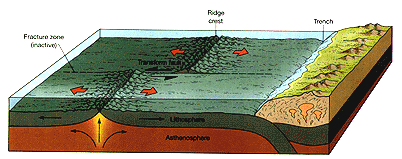

Subduction Zone
 When an oceanic plate runs into a continental plate, the oceanic, denser, plate is pushed down into the mantle, creating a Subduction Zone. This plate boundary is also called a Convergent Boundary. When the oceanic plate goes down far enough, it melts and the molten rock rises creating volcanoes on the continental plate. In this situation crust is being destroyed. The place where the two plates are touching and a depression is created is called a trench. Since the plate being melted is oceanic, it contains some amount of water. When the molten rock rises to the surface, the steam, from the water being heated, usually causes an explosion called a phreatic
explosion. An example of a Subduction Zone is the boundary between the Pacific Plate and the North American Plate. The Pacific plate runs into the North American Plate and is pushed under. It then melts and rises up to create the mountains of the western United States.
When an oceanic plate runs into a continental plate, the oceanic, denser, plate is pushed down into the mantle, creating a Subduction Zone. This plate boundary is also called a Convergent Boundary. When the oceanic plate goes down far enough, it melts and the molten rock rises creating volcanoes on the continental plate. In this situation crust is being destroyed. The place where the two plates are touching and a depression is created is called a trench. Since the plate being melted is oceanic, it contains some amount of water. When the molten rock rises to the surface, the steam, from the water being heated, usually causes an explosion called a phreatic
explosion. An example of a Subduction Zone is the boundary between the Pacific Plate and the North American Plate. The Pacific plate runs into the North American Plate and is pushed under. It then melts and rises up to create the mountains of the western United States.
Spreading Ridge
 When magma rises up from the mantle, in a process called upwelling, and pushes against an oceanic plate, it starts to make the plate thinner. This thin crust is called a rift. Once the magma breaks through the crust, it is considered a Spreading
Ridge. This plate boundary is also called a Divergent Boundary. A good example of a spreading ridge is a mid-ocean spreading ridge. In the middle of the ocean, the oceanic plates are coming apart and magma is rising through the space created. In the case of the spreading ridge crust is being created by the rising magma.
When magma rises up from the mantle, in a process called upwelling, and pushes against an oceanic plate, it starts to make the plate thinner. This thin crust is called a rift. Once the magma breaks through the crust, it is considered a Spreading
Ridge. This plate boundary is also called a Divergent Boundary. A good example of a spreading ridge is a mid-ocean spreading ridge. In the middle of the ocean, the oceanic plates are coming apart and magma is rising through the space created. In the case of the spreading ridge crust is being created by the rising magma.
Transform Boundary
 A Transform Boundary is where two plates are sliding next to each other. The plates are just sliding by each other. The place where they touch and rub together is called a fault. They often occur in the middle of a spreading ridge where the boundary bettween the plates isn't perfectly straight, and there is a place where the plates are sliding past each other. The rubbing of the two plates together is what causes earthquakes. The pressure builds up and then releases all the energy in the form of an earthquake. An example of a transform boundary is where part of the Juan De Fuca Plate and the Pacific Plate are touching off the coast of Washington and Oregon.
A Transform Boundary is where two plates are sliding next to each other. The plates are just sliding by each other. The place where they touch and rub together is called a fault. They often occur in the middle of a spreading ridge where the boundary bettween the plates isn't perfectly straight, and there is a place where the plates are sliding past each other. The rubbing of the two plates together is what causes earthquakes. The pressure builds up and then releases all the energy in the form of an earthquake. An example of a transform boundary is where part of the Juan De Fuca Plate and the Pacific Plate are touching off the coast of Washington and Oregon.